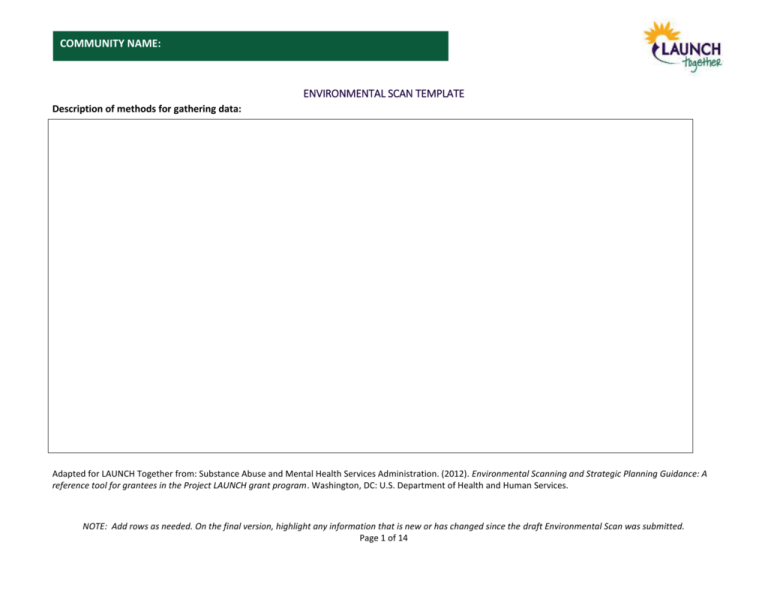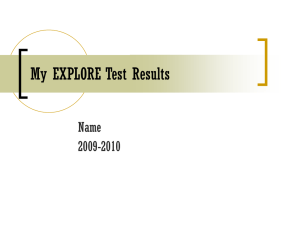Environmental Scan Template a Word
advertisement

COMMUNITY NAME: ENVIRONMENTAL SCAN TEMPLATE Description of methods for gathering data: Adapted for LAUNCH Together from: Substance Abuse and Mental Health Services Administration. (2012). Environmental Scanning and Strategic Planning Guidance: A reference tool for grantees in the Project LAUNCH grant program. Washington, DC: U.S. Department of Health and Human Services. NOTE: Add rows as needed. On the final version, highlight any information that is new or has changed since the draft Environmental Scan was submitted. Page 1 of 14 COMMUNITY NAME: NOTE: Add rows as needed. On the final version, highlight any information that is new or has changed since the draft Environmental Scan was submitted. Page 2 of 14 COMMUNITY NAME: Prevention and Health Promotion Strategy: Integration of Behavioral Health into Primary Care When scanning the early childhood environment related to behavioral health in primary care, consider the following guiding questions. What is being done to ensure that: all children are connected to a medical home? medical providers conduct regular comprehensive developmental screenings and assessments? the state Medicaid system recognizes developmental screenings and assessments as critical components of the well-child visits and reimburses providers for the service? medical providers explore mental health issues with family members? families are connected to traditional and spiritual leaders? early childhood providers (e.g. home visitors, early intervention specialists, WIC, child care, etc.) have mechanisms to communicate and coordinate with medical providers? Service provided Organization providing service (include length of time in community) Population served (age range and/or population characteristics) Geographic reach Goals and outcomes Funding amount and source Data system (type of data collected and how stored) Demand (number of children on wait lists and eligible population not served) NOTE: Add rows as needed. On the final version, highlight any information that is new or has changed since the draft Environmental Scan was submitted. Page 3 of 14 COMMUNITY NAME: Other partners supporting collaborative local systems efforts (not providing direct services): Workforce capacity and knowledge of children and family’s behavioral health: Gaps, barriers or duplications in services and local systems: Other considerations: NOTE: Add rows as needed. On the final version, highlight any information that is new or has changed since the draft Environmental Scan was submitted. Page 4 of 14 COMMUNITY NAME: Prevention and Health Promotion Strategy: Mental Health Consultation in Early Care and Education When scanning the early childhood environment related to mental health consultation in early care and education, consider the following guiding questions. What is being done to: build a local early childhood and education workforce, including small and/or informal providers, with competence in young child social, emotional and behavioral health? develop or strengthen a network of child care health consultants? make developmental screenings available through early care and education systems? link providers with the early intervention system? help providers connect families to parenting education resources and programs? ensure that early childhood settings serve as an access point for health insurance and medical homes? ensure that early childhood settings are culturally sensitive and appropriate? support collaboration between the early care and education system, local education agency and other agencies or stakeholders related to young child wellness? Service provided Organization providing service (include length of time in community) Population served (age range and/or population characteristics) Geographic reach Goals and outcomes Funding amount and source Data system (type of data collected and how stored) Demand (number of children on wait lists and eligible population not served) NOTE: Add rows as needed. On the final version, highlight any information that is new or has changed since the draft Environmental Scan was submitted. Page 5 of 14 COMMUNITY NAME: Other partners supporting collaborative local systems efforts (not providing direct services): Workforce capacity and knowledge of children and family’s behavioral health: Gaps, barriers or duplications in services and local systems: Other considerations: NOTE: Add rows as needed. On the final version, highlight any information that is new or has changed since the draft Environmental Scan was submitted. Page 6 of 14 COMMUNITY NAME: Prevention and Health Promotion Strategy: Enhanced Home Visitation When scanning the early childhood environment related to enhanced home visiting, consider the following questions. What is being done to: ensure home visitors are trained on social and emotional well-being and behavioral health of young children and families? integrate social-emotional and behavioral health screenings into home visiting programs? provide reflective supervision and case consultation for home visiting staff? increase coordination and information sharing across home visiting programs? perform brief intervention prior to a warm handoff for additional services and supports? Service provided Organization providing service (include length of time in community) Population served (age range and/or population characteristics) Demand Geographic reach Goals and outcomes Funding amount and source Data system (type of data collected and how stored) (number of children on wait lists and eligible population not served) NOTE: Add rows as needed. On the final version, highlight any information that is new or has changed since the draft Environmental Scan was submitted. Page 7 of 14 COMMUNITY NAME: Other partners supporting collaborative local systems efforts (not providing direct services): Workforce capacity and knowledge of children and family’s behavioral health: Gaps, barriers or duplications in services and local systems: Other considerations: NOTE: Add rows as needed. On the final version, highlight any information that is new or has changed since the draft Environmental Scan was submitted. Page 8 of 14 COMMUNITY NAME: Prevention and Health Promotion Strategy: Family Strengthening When scanning the early childhood environment related to family strengthening, consider the following guiding questions. Do families have access to: parenting education and support? two-generation family strengthening programs? programs that build parents’ skills to advocate for themselves and their children, including interacting with professional regarding child wellness issues? programs that provide parent-to-parent educational and support activities? culturally and linguistically appropriate supports? information about the importance of children’s social and emotional development? Service provided Organization providing service (include length of time in community) Population served (age range and/or population characteristics) Demand Geographic reach Goals and outcomes Funding amount and source Data system (type of data collected and how stored) (number of children on wait lists and eligible population not served) NOTE: Add rows as needed. On the final version, highlight any information that is new or has changed since the draft Environmental Scan was submitted. Page 9 of 14 COMMUNITY NAME: Other partners supporting collaborative local systems efforts (not providing direct services): Workforce capacity and knowledge of children and family’s behavioral health: Gaps, barriers or duplications in services and local systems: Other considerations: NOTE: Add rows as needed. On the final version, highlight any information that is new or has changed since the draft Environmental Scan was submitted. Page 10 of 14 COMMUNITY NAME: Prevention and Health Promotion Strategy: Screening and Assessment When scanning the early childhood environment related to screening and assessment, consider the following guiding questions. What is being done to: ensure the use of valid screening tools and protocols? educate parents regarding the importance of screening and screening results? make appropriate referrals, follow-up and ongoing care coordination? train providers on screening and assessment using valid tools? advance systemic efforts to implement universal screening? support children and their parents/caregivers through screening for pregnancy-related depression and broader parental health screening? Service provided Organization providing service (include length of time in community) Population served (age range and/or population characteristics) Demand Geographic reach Goals and outcomes Funding amount and source Data system (type of data collected and how stored) (number of children on wait lists and eligible population not served) NOTE: Add rows as needed. On the final version, highlight any information that is new or has changed since the draft Environmental Scan was submitted. Page 11 of 14 COMMUNITY NAME: Other partners supporting collaborative local systems efforts (not providing direct services): Workforce capacity and knowledge of children and family’s behavioral health: Gaps, barriers or duplications in services and local systems: Other considerations: NOTE: Add rows as needed. On the final version, highlight any information that is new or has changed since the draft Environmental Scan was submitted. Page 12 of 14 COMMUNITY NAME: Define your population of focus for LAUNCH Together, geographic area and approaches to addressing health equity: NOTE: Add rows as needed. On the final version, highlight any information that is new or has changed since the draft Environmental Scan was submitted. Page 13 of 14 COMMUNITY NAME: NOTE: Add rows as needed. On the final version, highlight any information that is new or has changed since the draft Environmental Scan was submitted. Page 14 of 14





